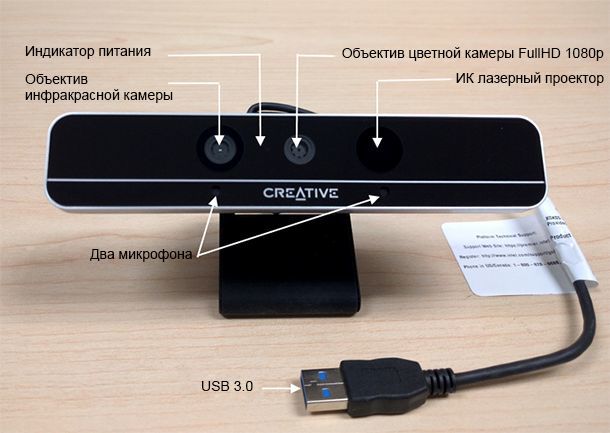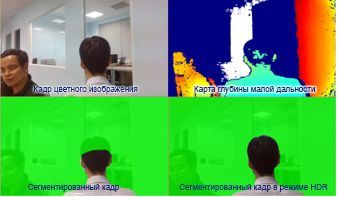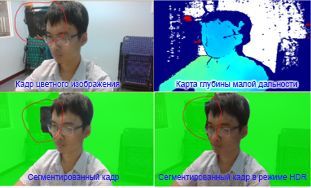Introducing the new Intel RealSense SR300 Camera
The Intel RealSense SR300 Camera is the latest front-view camera in our product line. The SR300 has a number of new and improved features compared to the first-generation Intel RealSense F200 cameras. In the SR300 model, the range of the camera is increased to 1.5 m and the recording of dynamic movement is maintained, the accuracy of the depth data is improved, the power consumption is reduced, and the quality and stability of the software is improved. Improved Skype * support in SR300 cameras. The resolution is 1080p FullHD at 30 frames per second or 720p at 60 frames per second. The SR300 supports applications developed for the Intel RealSense F200 Camera, and color image processing. The Intel RealSense SDK adds a new 3D Cursor mode, improves the segmentation of the background and the 3D scanning feature for the SR300 camera.

The Intel RealSense SR300 and F200 Front View Camera Comparison article lists the differences between the SR300 and F200 models and the reasons for switching to the SR300.
The dimensions of the SR300 are 110 x 12.6 x 3.8–4.1 mm, weight - 9.4 g. Thanks to its compact size and light weight, the camera can be mounted on the lid of a mobile device or on a desktop monitor, resulting in stable video recording. In 2016, the SR300 camera will be integrated into various devices, including PCs, all-in-one PCs, laptops and transformers. The SR300 can use the Intel RealSense SDK for Windows or librealsense software. SR300 camera support has been added to SDK version 2016 R1 and later.
')
New opportunities:
Improved features:
See the Intel RealSense SR300 and F200 Front View Camera Comparison page for more information on VGA accelerated mode and other new and improved features.
In future releases of the Intel RealSense SDK, new and updated features will be implemented: automatic distance determination, high dynamic range mode, and a confidence map.
Scheduled for the second half of 2016
Automatic distance detection improves image quality, especially at short ranges. This feature controls near-field laser gain and long-range exposure.
In this mode, the dynamic range of the image is expanded. Dynamic range is the ratio between the lightest and darkest areas of an image. When HDR mode is on, the image detail is enhanced. HDR mode is useful when shooting in low light conditions or when shooting against the light. At the same time, sufficient frame rate is maintained.
When the HDR mode is on, the image increases the detail of the hair under normal lighting and backlit.

More hair data

Improved recognition of lighted hair
In the extended dynamic range mode, recognition accuracy is improved in difficult cases, for example, when a black foreground object is on a black background. This increases the quality of the background segmentation (BGS). The extended dynamic range mode will be available only for background segmentation, it cannot be used simultaneously with other components. More information will be available in the next version of the Intel RealSense SDK.

Black hair on a black background
The confidence map function provides confidence values for the depth map in the range from 0 to 15. For small values (0–4), a more accurate depth measurement is provided, larger values can be used to segment BLOB objects, detect edges and fill gaps.
The user segmentation module masks the background when the user is in front of the camera, so you can overlay the user's face over another background. This module is embedded in video conferencing applications. When HDR mode is turned on in the SR300 cameras, the quality of masks and color rendition in low light is significantly improved.
The color of the SR300 cameras is significantly improved in low light compared with F200 cameras; As a result, the quality of textures that can be applied to three-dimensional models for their visualization increases. Both front view cameras can scan a user's face or small items. At the same time, with the SR300 cameras, the shooting range is increased to 70 cm at 50 frames per second, as well as increased detail compared with the F200 cameras. You can use the Intel RealSense SDK to create a 3D image, and then post it on Facebook * using Sketchfab *. For more information about Sketchfab, see the articles Implementing Sketchfab Login in Applications and Sketchfab Integration . The 3D scanning module is built into AAA games for capturing and using the user's face on game characters.
The hand tracking module supports three basic modes: Cursor mode, limb mode, and full-hand mode. Cursor mode is a new feature supported by the SR300 camera only. This mode returns a single point for the hand, which allows you to very accurately track the three-dimensional position of the pointer and perform gestures. Cursor mode is used in cases where a quick, compact and accurate hand tracking is combined with several reliably recognizable gestures to work with the application. Cursor mode supports movement of the hand and click gesture. At the same time, compared with the tracking mode of the entire hand, the range and speed are doubled, there are no delays, and the power consumption is reduced.

Cursor mode
The Intel RealSense SR300 camera is equipped with a dual microphone for audio input into the client system. The use of two microphones increases the reliability of the voice module in a noisy environment.
** Distances are approximate.
The SR300 camera requires Intel RealSense Depth Camera Manager (DCM) version 3.x. At the time of this writing, the “golden” version of DCM 3.0.24.59748 is available for the SR300, and updates will be distributed via Windows Update 10. Visit the download page of the Intel RealSense SDK to download the latest version of DCM. For more information about DCM, see the Intel RealSense and DCM Camera Overview .
The Intel RealSense Camera supports firmware upgrades using the DCM driver. If a firmware update is required, the DCM driver will display a corresponding notification that must be received by the user before proceeding.
To support the bandwidth required by the Intel RealSense camera, the client system must have a powered USB 3.0 port. The SR300 camera requires a computer with an Intel Core processor of the 6th or later generation running the Windows 10 operating system. For details on the system requirements and supported operating systems for the SR300 and F200 cameras, see the Developer Kit page.
This document describes the new features of the Intel RealSense SR300 Front View Camera, which are supported in current and future versions of the Intel RealSense SDK. Go to this page to download the latest version of the Intel RealSense SDK. Order a new camera here .
Here are some useful links to the Intel RealSense DCM and SDK, including release notes and instructions for installing and updating software.

The Intel RealSense SR300 and F200 Front View Camera Comparison article lists the differences between the SR300 and F200 models and the reasons for switching to the SR300.
The dimensions of the SR300 are 110 x 12.6 x 3.8–4.1 mm, weight - 9.4 g. Thanks to its compact size and light weight, the camera can be mounted on the lid of a mobile device or on a desktop monitor, resulting in stable video recording. In 2016, the SR300 camera will be integrated into various devices, including PCs, all-in-one PCs, laptops and transformers. The SR300 can use the Intel RealSense SDK for Windows or librealsense software. SR300 camera support has been added to SDK version 2016 R1 and later.
')
New and improved features
New opportunities:
- Cursor mode
- Person tracking
Improved features:
- Increased range and lateral speed
- Enhanced color quality when shooting with insufficient lighting, improved three-dimensional textures for three-dimensional scanning
- Improved color flow and depth synchronization
- Reduced power consumption
See the Intel RealSense SR300 and F200 Front View Camera Comparison page for more information on VGA accelerated mode and other new and improved features.
Additional features of the Intel RealSense SDK scheduled for the SR300 camera
In future releases of the Intel RealSense SDK, new and updated features will be implemented: automatic distance determination, high dynamic range mode, and a confidence map.
Scheduled for the second half of 2016
▍Automatic distance detection
Automatic distance detection improves image quality, especially at short ranges. This feature controls near-field laser gain and long-range exposure.
▍ High Dynamic Range (HDR) Mode
In this mode, the dynamic range of the image is expanded. Dynamic range is the ratio between the lightest and darkest areas of an image. When HDR mode is on, the image detail is enhanced. HDR mode is useful when shooting in low light conditions or when shooting against the light. At the same time, sufficient frame rate is maintained.
When the HDR mode is on, the image increases the detail of the hair under normal lighting and backlit.

More hair data

Improved recognition of lighted hair
In the extended dynamic range mode, recognition accuracy is improved in difficult cases, for example, when a black foreground object is on a black background. This increases the quality of the background segmentation (BGS). The extended dynamic range mode will be available only for background segmentation, it cannot be used simultaneously with other components. More information will be available in the next version of the Intel RealSense SDK.

Black hair on a black background
Reliability map
The confidence map function provides confidence values for the depth map in the range from 0 to 15. For small values (0–4), a more accurate depth measurement is provided, larger values can be used to segment BLOB objects, detect edges and fill gaps.
Estimated use of SR300
- Tracking the skeleton of the entire hand, gesture recognition
- Cursor mode
- Head tracking
- 3D segmentation and background removal
- Augmented Reality with Advanced Depth Mapping
- Voice control
- 3D scan of faces and objects
- Face recognition
Camera applications
▍ Dynamic background segmentation
The user segmentation module masks the background when the user is in front of the camera, so you can overlay the user's face over another background. This module is embedded in video conferencing applications. When HDR mode is turned on in the SR300 cameras, the quality of masks and color rendition in low light is significantly improved.
▍Three-dimensional scanning
The color of the SR300 cameras is significantly improved in low light compared with F200 cameras; As a result, the quality of textures that can be applied to three-dimensional models for their visualization increases. Both front view cameras can scan a user's face or small items. At the same time, with the SR300 cameras, the shooting range is increased to 70 cm at 50 frames per second, as well as increased detail compared with the F200 cameras. You can use the Intel RealSense SDK to create a 3D image, and then post it on Facebook * using Sketchfab *. For more information about Sketchfab, see the articles Implementing Sketchfab Login in Applications and Sketchfab Integration . The 3D scanning module is built into AAA games for capturing and using the user's face on game characters.
▍ Hand Gesture Recognition: Cursor mode is supported only by the SR300 camera
The hand tracking module supports three basic modes: Cursor mode, limb mode, and full-hand mode. Cursor mode is a new feature supported by the SR300 camera only. This mode returns a single point for the hand, which allows you to very accurately track the three-dimensional position of the pointer and perform gestures. Cursor mode is used in cases where a quick, compact and accurate hand tracking is combined with several reliably recognizable gestures to work with the application. Cursor mode supports movement of the hand and click gesture. At the same time, compared with the tracking mode of the entire hand, the range and speed are doubled, there are no delays, and the power consumption is reduced.

Cursor mode
Two microphones
The Intel RealSense SR300 camera is equipped with a dual microphone for audio input into the client system. The use of two microphones increases the reliability of the voice module in a noisy environment.
Intel RealSense SR300 Camera Specifications
| SR300 Camera | |
|---|---|
| Range** | 0.2–1.2 m indoors, without direct sunlight |
| Depth / IR | Resolution 640 x 480 at 60 fps |
| Color Camera ** | Resolution up to 1080p at 30 fps, 720p at 60 fps |
| Depth camera ** | Resolution up to 640 x 480 at 60 fps (Fast VGA, VGA), HVGA at 110 fps |
| IR camera ** | Up to 640 x 480 at 200 fps |
| Interface to connect to the motherboard | USB 3.0, 5 V, GND |
| Developer Kit Dimensions ** | 110 x 12.6 x 3.8–4.1 mm |
| Weight** | 9.4 g |
| Required OS | 64-bit version of Microsoft Windows * 10 RTM |
| Tongue | C ++, C #, Visual Basic *, Java *, JavaScript * |
DCM driver
The SR300 camera requires Intel RealSense Depth Camera Manager (DCM) version 3.x. At the time of this writing, the “golden” version of DCM 3.0.24.59748 is available for the SR300, and updates will be distributed via Windows Update 10. Visit the download page of the Intel RealSense SDK to download the latest version of DCM. For more information about DCM, see the Intel RealSense and DCM Camera Overview .
Firmware update
The Intel RealSense Camera supports firmware upgrades using the DCM driver. If a firmware update is required, the DCM driver will display a corresponding notification that must be received by the user before proceeding.
equipment requirements
To support the bandwidth required by the Intel RealSense camera, the client system must have a powered USB 3.0 port. The SR300 camera requires a computer with an Intel Core processor of the 6th or later generation running the Windows 10 operating system. For details on the system requirements and supported operating systems for the SR300 and F200 cameras, see the Developer Kit page.
Conclusion
This document describes the new features of the Intel RealSense SR300 Front View Camera, which are supported in current and future versions of the Intel RealSense SDK. Go to this page to download the latest version of the Intel RealSense SDK. Order a new camera here .
Reference materials
Here are some useful links to the Intel RealSense DCM and SDK, including release notes and instructions for installing and updating software.
Source: https://habr.com/ru/post/283508/
All Articles